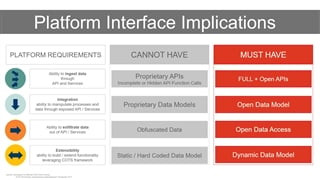Platform technology can power, or hinder, a company’s digital transformation. Earlier this year, this was the subject of a webinar, Digital Transformation: Platform Implications, with CIMdata Vice President, Stan Przybylinski, and Aras Strategy SVP, Marc Lind.The two discussed new requirements for industrial platforms to enable Digital Transformation initiatives. So, what differentiates one platform from another? Is your enabling technology transformation-empowering, or transformation-impeding, and how can you tell the difference?
1 – The Pace of Change: Can Your Platform Adapt?
“Tomorrow’s digital processes don’t exist today.”
Technology is advancing rapidly, and disruptors emerge quickly. To compete or, better yet, to get ahead, companies must be able to adapt their product and business strategies quickly. Rigid platform technologies are antithetical to digital transformation because they require companies to “lock in” business processes, tool integrations, and teams. With these technologies, any variation from heavily prescribed, out-of-the-box processes requires coding expertise and customizations that may be impossible to upgrade. Improving on this locked-in custom code later, or even attempting to upgrade the system to take advantage of the vendor’s latest release, is costly, disruptive, and can be as resource-intensive as a full re-implementation.
Tomorrow’s product and business requirements are not yet well-defined and, in many cases, are unknown or emerging. This means that any out-of-the-box software that doesn’t accept customizations easily and upgrade anyway, is ill-equipped at worst, and a gamble at best, when it comes time to adapt to tomorrow’s business needs. Companies need a platform capable of sustaining digital transformation, not one that prevents changes later.
Quickly adapting to new customer needs, new business strategies, and new product technologies as they evolve, not just right now but well into the future, is a new requirement for both a business and its platform. To sustain digital transformation, companies require the option to customize platform functionality today, and introduce new customizations and new processes offered by the vendor, tomorrow: in other words, it must offer a rich set of out-of-the-box functionality that is specifically designed for flexibility, customization, and upgradability.
2 – The Shared Nature of Change: Does Your Platform Scale?
Like dominoes, one change to a product’s data or lifecycle processes affects many other stakeholders, processes, and datasets. The ability to handle large datasets, growing numbers of users, and diverse processes, while continuing to evolve, is another new platform requirement that will enable digital transformation.
Connecting to the new people, processes, and technologies that will drive a company’s new product and business strategies requires the platform to be capable of inserting new technologies, initiating new workflows among new stakeholders, and connecting to more teams across the extended enterprise. Is your platform locked into today’s requirements, or can you extend it to accommodate new, evolving requirements of the business?
Similarly, does your platform lock you into a single software vendor and their compatible offerings, or can you connect your current tools and technologies to the platform to support existing best-practices? The requirement to “rip and replace” technology to accommodate a single vendor is an impossible ask. Prescribing the use of one vendor’s tools can grind business to a halt with re-training and new infrastructure needs. In today’s heterogeneous technology ecosystems, experts will, more likely than not, need tools from another vendor anyway, requiring them to work around the platform’s limitations and break the digital thread of product data and traceability. Changing your technology and processes to accommodate a single vendor’s limited processes and offerings amounts to the tail wagging the dog - especially when your expertise and your IP has made you, not them, successful in your industry thus far.
Platforms to enable digital transformation must be specifically designed to connect to new tools, experts, and processes in a vendor-agnostic way so that companies can continue to add innovative offerings from new and emerging providers. The ability to choose from among the best new technologies as they emerge, not just the ones offered by a single vendor, is critical to maintaining a competitive edge.
3 – The Interconnectedness of Change: Is Your Platform Open?
“You need to connect to all aspects of your business to be able to make that transformation.”
Platform technology has evolved from simply enabling product innovation, to powering business innovation, to advancing supply chain and industry innovation. This means it must be able to connect with other systems throughout the enterprise and across the value chain. To enable co-design scenarios for collaborative product development, and for lifecycle processes including manufacture and maintenance, the platform must support security and collaboration for many users from both internal teams and external partners across many different types of data.
Valuable data to support products, services, and business strategies comes from multiple domains. Can your platform assimilate a new domain into its data model—and can it interoperate across the supply chain? Does it understand data and processes across new domains like manufacturing, simulation, MRO, systems engineering, and beyond? Can your teams access and customize the data model, in a low-code/no code way that’s easily accessible and intuitive, or with coding if they so choose, and still be able to upgrade the platform?
The data model must be expansive, customizable, and continually expandable as the types of information it must connect to are expanding, as well. The architecture and data model must be dynamic, because, like your business, they are now subject to change. With traditional platforms, integrations can be very difficult to upgrade. But with an open data model available for connectivity to other tools and systems through completely open APIs, companies truly own their data model, change it whenever and however they need to, and can access their data freely.
Companies need open access to their own IP, along with the ability to change not only the data itself but the platform it resides on, including the related metadata generated by the platform. This is critical not only for today but for future machine-learning scenarios. Without access to the data model at every level, to ensure its accuracy, the opportunities for misinterpretations and misdirected analyses goes up. Machine learning algorithms need complete access to accurate data to train them, and they won’t work without this open data access in the future.
Conclusion: The Only Constant Is Change.
For rigid technologies, changes to hardwired, OOTB features, even if they are improvements needed by the company—even if they are improvements offered by the vendor—become impossible to make. Let that sink in: improvements become impossible to make.
If you can’t change, update, improve, and make a platform technology work for your teams, your products, and your processes, that technology is currently hindering your company’s ability to transform. Is it even a platform at that point, or just another siloed tool? Companies embarking on digital transformation can’t risk their future, unknown business strategies—and the future, emerging needs of their customers—on technology they can’t change.


